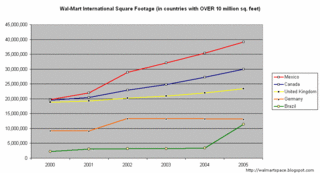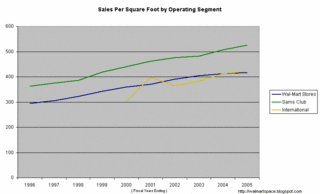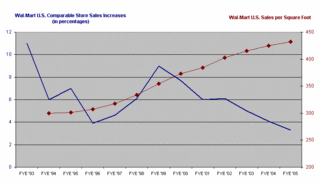Reconciling the net income valuation to the cash flow model... Part 1 in a discussion of Wal-Mart's free cash flow
For those somewhat familiar with free cash flow, let me quickly define the term as I’m using it…
Free Cash Flow =
Net income + Depreciation and Amortization – Capital Expenditures
The above formula gives us the total amount of cash that we can actually take out of the business every year. (Wal-Mart actually does take this cash out of the business every year in the form of dividends to shareholders.)
I am now going to modify the above formula to tailor it more specifically for Wal-Mart’s cash related operations.
Free Cash Flow =
Net cash from operations + Depreciation and Amortization – Capital Expenditures
The “net cash from operations” is different than “net income”. Net income is of course the first line of the cash flow statement. I am choosing to take into account all of the cash produced by operations and this includes things like reductions in cash due to increases in inventories and additions to cash due to increases in accounts payable. The net cash from operations is in fact the whole top portion of the cash flow statement listed under “Operating Activities.” Net income is the first line item in that section.
Now let me quickly indicate how I am defining CapEx from Wal-Mart’s cash flow statement:
Payments for property and equipment
+
Investment in international operations
-
Proceeds from the disposal of fixed assets
Initially I thought I would not include the third portion above, but in the end decided to include it as Wal-Mart is slowly selling off its old real estate as they acquire new real estate in the conversion process from Discount Stores to Supercenters. The rebate they get by selling the old real estate (i.e. during the conversion process) should be considered here and so I included it in the calculation.
So, given all of the above definitions, Wal-Mart’s free cash flow in fiscal 2005 was $2.79 billion. That number is obviously significantly less than the $10.27 billion in net income for fiscal 2005. When we go down the road of cash flow analysis we have to be very clear about what is going on, and so in doing the cash flow analysis on Wal-Mart, let’s be very clear that a large amount of Wal-Mart’s net income (and actually even more than its net income) is being re-invested back into the business on our behalf (on behalf of the shareholders). This should not be considered problematic in any way. Remember that it is the RETURN on the re-invested capital, it is the return on that cap-ex, that we then must take into account if we wish to perform a fair and correct cash flow analysis.
I am going to take a break here to allow for all of the above to be digested, and next we’ll begin to analyze what the returns on cap-ex look like.









